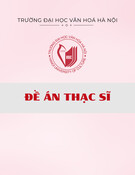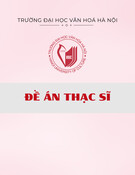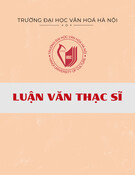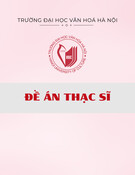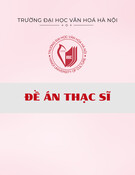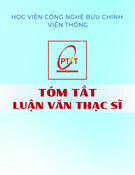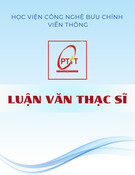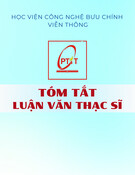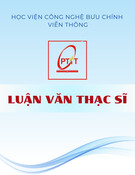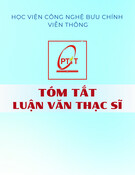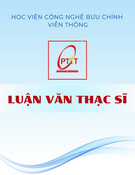1 2
CHAPTER 1: GENERAL INTRODUCTION 1.1 Background to the study tourists, thereby helping to keep tourists staying longer and at the same time increasing the intention to return with the same intention to spread the word of mouth promoting the tourist destination to relatives and friends.
The community tourism is a type of tourism developed on the basis of the cultural values of the community, managed by a residential community, exploited and benefited (Law on Tourism, 2017). The types of the community tourism include: Ecotourism, agricultural and rural tourism, village tourism, ethnic or indigenous tourism, and cultural tourism (Public tourism development guidelines, 2012).
Practical background The Northwest has many potentials to develop the community tourism which are included: Unique cultural identity and customs of more than 20 ethnic minorities, a system of historical relics, rich festivals, the attractive nature, but those potentialities have not been exploited effectively for tourism development. Therefore, one of the important directions to develop tourism on the basis of exploiting, promoting and preserving the traditional cultural values of ethnic groups (Pham Trung Luong, 2015).
On the other hand, the community tourism activities are only developed sustainably if they pay attention to preserving the landscape and protecting the environment. The environment will have a direct influence on the socio-economic development in general, tourism in particular and the life of the community (Tran Duc Thanh, 2005). Therefore, in parallel with the solutions for the community to develop socio-economic through tourism activities, it is necessary to raise awareness for people to do well in environmental protection, which will help the community to develop socio-economic and improve the material and spiritual life in a sustainable way.
Currently, the community tourism is considered as a type of tourism that brings many sustainable economic development benefits to indigenous people. The community tourism not only helps people to protect ecological environmental resources, but also preserves and promotes the unique local cultural features. Vietnam has a lot of potentials in natural landscapes, historical values, indigenous cultures of the ethnic groups, rich customs and lifestyles, and culinary cultures of different regions which are the basis for strong development of the community tourism (Doan Manh Cuong, 2019). Theoretical background Customer satisfaction is an important factor not only in the tourism industry, but also plays an important role in many other service industries. Therefore, the research on tourist satisfaction is the topic of great interest from many scholars and researchers (Baloglu, 1999), (Xia et al, 2009).
In recent years, promoting tourism development has always been considered a top development priority in the economic development orientation of localities in the Northwest region. However, tourism in the Northwest region has not yet developed to its potential. “In reality, tourism development in the Northwest still faces many difficulties and limitations, many obstacles, notably difficulties in resources, tourism infrastructure, attracting investment, especially the effect on the results of developing the community tourism is not high” (Northwest Steering Committee, 2013, page 5). Tourists participate in the community tourism activities to explore the nature and indigenous cultural identity. The research of Brent Ritchie and Michel Zins (1978) confirmed: Culture is the decisive factor to the attractiveness of a tourist area. So why is the indigenous culture of the Northwest region considered to have many specialties, richness and national identity, still not completely appealing to tourists?
Visitor satisfaction is an important contributor to the increase in the profit of the tourism operator and the development of the tourism industry in the destinations. Some studies have shown that a 5% increase of the visitor satisfaction, the loyalty to a tourist agency can increase profits by 25-95% (Chi & Qu, 2008). Several other studies have shown that a 5% reduction in the number of visitors leaving a tourism organization will increase their profits by about 85% (Augustyn & Ho, 1998). Along with that, the cost of maintaining tourist satisfaction and loyalty is much lower than the cost of attracting new tourists (Beerli & Martin, 2004). The main purpose of satisfaction is the feeling and perception of the visitors about the quality of the service at the destination (or it can be called tourist destination quality) (Baker & Crompton, 2000). Destination quality is the quality of tourism services that providers provide to tourists at the destination such as: Traffic, security, entertainment services, environmental landscapes, local cultural identity, telecommunications services, friendliness of the locals, food, souvenir products.
The tourism activities in general and community-based tourism in particular, if the quality of service is improved at the destination, it will increase the satisfaction of The Northwest Steering Committee (2017) statistics, although the number of tourists in the community tourism in the Northwest region had continuously increased, but 88,2% of domestic tourists came from northern provinces of Vietnam, so most Domestic visitors left in the same day at the rate of 61%. In particular, many domestic tourists said that they did not return to travel (accounting for about 27,9%). the This shows individuals, households participating that organizations, in
3 4
4. Which solution will improve the satisfaction of community tourists, contribute to attracting tourists and promote the development of community tourism in the Northwest? 1.4 Participants, scope, and methods of the study 1.4.1 Participants The community tourism in the North West region and the impact of these
factors on tourist satisfaction when experiencing the community tourism. 1.4.2 Scope community tourism activities and local authorities need to reassess their capacity to provide the community tourism services to attract returning visitors as well as prolonging the tourist's stay. Therefore, it is necessary to have the research on the satisfaction of tourists participating in the community tourism in the Northwest, find out the influencing factors as well as specify the impact level of each factor on the satisfaction of community tourists. On that basis, proposing solutions to improve the quality of destination services, overcome the shortcomings in order to better meet and satisfy the needs of the community tourists in the Northwest.
From the above practices and theories, the author chose: "Research on factors affecting the satisfaction of the community tourists in the Northwestern" as the research topic. 1.2 Aim of the study
- Scope of content: The dissertation will study the development of the community based tourism in terms of sales, number of tourists, tourist sites, infrastructure and human resources for community tourism. In addition, the study also focuses on analyzing the satisfaction of the community tourists and the impact of factors affecting the satisfaction of tourists when experiencing the community tourism in the Northwest.
The objective of the dissertation is to research and explore the factors and the impact level of these factors on the satisfaction of community tourists in the Northwest. Since then, proposing solutions to help improve the quality of destination services at the community tourism destinations in the Northwest to better satisfy the needs of the community tourists in the Northwest. - Scope of space: This dissertation collects samples based on random visitor visits to the the community tourism attractions in four provinces: Hoa Binh, Son La, Dien Bien, Lai Chau. During the period from September 2017 to April 2018. To accomplish the above research objectives, the dissertation conducted the following research tasks: - Scope of time: The author determines the study conducted from 2015 to 2019. First: Systematize the theoretical basis of the community tourism, destination quality and community tourist satisfaction. 1.4.3 Researh methods 1.4.3.1 The method of data collection Second: Determinie the research model of factors affecting the satisfaction of the community tourists. Third: Assess the current status of the community tourism development and the impact of factors affecting the satisfaction of the community tourists in the Northwest.
The method of data collection is done through collecting secondary data from previous studies in Viet Nam and abroad, reports at the Department of Culture, Sports and Tourism, Department of Statistics, Vietnam national administration of tourism. Collect primary data through the survey questionnaire system by using the collaborators to directly distribute and receive survey questionnaires to tourists experiencing the community tourism in the Northwest. 1.4.3.2 Methods of analysis and data processing
Fourth: Base on the results of solving the above objectives, the dissertation proposes solutions to help improve the quality of destination services at the community tourism destinations in the Northwest in order to improve the satisfaction of tourists. Northwest community. 1.3 Research questions
a) Analysis of secondary data Secondary data are statistics of Vietnam national administration of tourism, Departments of Culture, Sports and Tourism of provinces, scientific works of domestic and foreign authors. The dissertation is done to answer the following questions: 1. What factors affect the satisfaction of the community tourists? 2. What is the impact of these factors on the community tourists’ satisfaction in the Northwest? 3. What is the current situation of the community tourism development in the Northwest?
Apply the methods: + Synthesize statistics and analysis + Analysis and synthesis of theory + Classification and system theory + Modeling
5 6
+ Scientific thinking in interpretation and inductive, from concrete to abstracting the problem. To clarify through the steps of collecting, analyzing, comparing and evaluating a number of studies on the impact of indigenous culture and other factors on tourist satisfaction. At the same time, consider the previous related research models to form the theoretical framework and research model of the dissertation.
b) Analysis of primary data - Qualitative research (interviewing experts from there to analyze qualitative data: strip removal, manually process (synthesize opinions, count the frequency of important words, record important answers ...). associated with traditional professions and local characteristics have not been exploited. Thus, in order to develop the community tourism sustainably, to attract tourists, localities must both "exploit" and "accumulate, build", that is to promote indigenous cultural elements, the elements of the local traditional profession to please tourists, motivating visitors to come back in the next time. With the above principle of tourism supply - demand, we can see the role of indigenous cultural factors for the development of community tourism. Therefore, the addition of the element "indigenous culture" in tourism development research is very necessary and is a new contribution point in the dissertation topic of the author.
Third, to measure the factor "indigenous culture", the author added two measurement indicators, namely unique handicrafts, rich identity and unique traditional brocade products, through discussion opinions with experts, the author assessed these are typical indicators of community tourism in the Northwest. These two indicators are also agreed by experts in the preliminary research process and are used in the official research of the dissertation, with the results showing that the scales ensure reliability, appropriate combination. measurement indicators inherited from previous studies to measure indigenous cultural factors.
- Analyzing quantitative data: First of all, reliability analysis and factor analysis are used to measure the reliability and validity of the measures from which to evaluate the measure, determine the confidence level and the influence of the factors. Then, the bi-variate correlation was analyzed to test the pairing relationship of variables. Finally, multiple regression analysis was performed to determine the relationship between the independent variable, the intermediate variable and the dependent variable. The analysis of data is done through statistical processing software (SPSS, AMOS) version 20.0 to check and correct the unsuitable variables and scales when entering the research model facing to problems such as: variable random error variance, multiple collinearity, non-standard distributed random error. 1.5 New contributions of the dissertation
The dissertation has contributed both in terms of theory and practice, as follows: In terms of theory: the research results have new or confirmed points compared to the studies the author has already known are:
Fourth, previous studies have shown the impact of the factor "destination quality" on tourist satisfaction. However, in the community tourism, local people are the main target for providing products and services to tourists. Therefore, the satisfaction of tourists in the community tourism is not only affected by the destination image but also by the overall factors of the destination such as: Sightseeing environment, facilities, indigenous culture, natural conditions, travel prices. These are research results that have been shown when analyzing the research model.
the Firstly, the community tourism is a tourism model mainly based on local people, local traditional cultural values as well as specific indigenous cultures is the main attraction for tourists to explore, learn about the locality. Therefore, individual tourists' satisfaction is directly affected by factors "indigenous culture". The researches on indigenous cultural factors are mostly foreign studies, indigenous culture characteristics of the Northwestern region of Vietnam have many unique and different
In terms of practice: This research helps state management agencies such as the Department of Culture, Sports and Tourism, travel agencies, tourism business people and communities in the Northwest know the feeling of community tourists about local community tourism products, know what factors the customer is satisfied and which are not so that they can have solutions to improve the quality of tourism services, maintain, preserve and promote the cultural values in order to increase the attraction of community tourists in the locality. study has proposed scientific-based, feasible The and
effective recommendations to improve the satisfaction of visitors when participating in the community tourism in the Northwest region with the aim of developing community based tourism. Northwest region in the process of international integration of Vietnam. This study will contribute to supplement and provide a reference source for future research to enhance the tourism image of the Northwest region. Secondly, according to the principle of tourism supply - demand, tourism demand arises when people's income increases, creating conditions for people to satisfy their needs, including tourism needs. Society is increasingly modern, people tend to come to explore "the pristine tourist destinations", rich in indigenous cultural traditions, majestic natural landscapes (community tourism) instead of "luxury and magnificent tourist spots". When the demand for tourism arises, the supply is also gradually improving to meet the demand. Accordingly, the infrastructure at the community tourism sites is constantly improving, cultural identity in each locality is preserved, restored to create features that attract tourists. However, experts assessed that although Vietnam is aware of the role of cultural factors in tourism development in general and the community tourism in particular, it remains weak, tourism
7 8
1.6 Outline of the dissertation
Besides the guarantee, the table of contents, the list of tables, the list of figures, the list of works related to the dissertation, a list of references and appendices, the main content of the thesis is structured with 5 chapters: (i) Characteristics of the community tourism. (ii) Assess the potential of the community tourism development in the Northwest region in terms of: Climate and soil potential; Potential in indigenous culture, specialties in the Northwest.
(iii) Analyze the current status of the community tourism development in the Northwest of the community tourism destinations: Number of visitors and tourism revenue; facilities for community tourism; human resources for community tourism; and tourism promotion and promotion. Chapter 1: General introduction. Chapter 2: Literature review and theoretical basis. Chapter 3: Methodology. Chapter 4: The results. Chapter 5: Recommendations.
CHAPTER 2 LITERATURE REVIEW AND THEORETICAL BASIS
2.1 Literature review 2.1.1 Research on the community tourism (iv) Combine the analysis of the current situation of cultural heritage conservation with the community tourism development in the Northwest. The accessible cultural heritages: Physical cultural heritage; heritage of historical artifacts, landscapes’ history and culture, and intangible cultural heritages. 2.1.2 Research on community tourists’ satisfaction
Suthathip Suanmali (2014) studied the factors affecting tourist satisfaction in the northern provinces of Thailand. The study was conducted in a northern Thai province, Chiang Mai, where there are many natural and cultural attractions. Influencing factors are determined using statistical techniques. Primary data was collected through distributing random questionnaires to foreign tourists visiting Chiang Mai. Quantitative data was then analyzed using factor analysis and multiple regression analysis to identify important factors. Research results showed that the most important factor affecting visitor satisfaction was the cost of stay, the next most important factors were hospitality, natural landscape and infrastructure. The authors Rojan Baniya, Unita Shrestha and Mandeep Karn (2018) conducted research on the community tourism in Nepal. The research results showed that the development of community based tourism plays an important role in helping to reduce poverty, create positive changes for individuals, communities and society. Tourists participating in the community tourism often had better health, satisfaction with life and better community bonding. The community tourism contributed to stimulating the local economy to develop, raise awareness and preserve cultural heritages and traditions, preserve the beauty of local traditional culture, generate income and improve the spiritual and material life of local people. However, the community tourism development activities in Nepal currently face many challenges due to the lack of appropriate mechanisms and lack of the local authority’s involvement.
Smith's research (1994) showed that service activities in the community tourism such as viewing the scenery, accommodation, seats while visiting, enjoying different types of ethnic cultures belonged to the indigenous culture’s elements would help to make the "core physics of the tourism product" useful and attractive to visitors. According to Diabo (2003), tourism has a close relationship with "commercial values", culture of indigenous communities had a decisive role to the satisfaction of visitors, directly affecting tourism activities on their own land.
Naidoo et al. (2011) conducted a study aimed at examining the community tourists’ assessment of natural tourism on the island of Mauritius. Research was carried out to determine the factors influencing the satisfaction of the community tourists for nature tourism in Mauritius. Factors mentioned to consider the impact on the community tourists’ satisfaction include: Infrastructure, prices, indigenous culture, safety, and natural resources on a scale developing from Parasuraman's scale of service quality. Research methods applied to the research include: test the reliability of the Crobach's Alpha scale, exploratory factor analysis, linear regression. The research results were conducted through interviews with 600 community tourists showed that the factors in the research model have statistical significance and impact on visitor satisfaction, in which factors Natural resources have the strongest impact. 2.1.3 Researchgap
First, the community tourism’s content - The studies have not yet analyzed and assessed the potential of developing the community tourism based on a full approach include: The potentials on climate It can be seen that the studies have had different perspectives in the community-based approach, however, when applying in practice, there are still many difficulties, the opinions of local communities are not paid attention. In addition, there are very few studies presenting the characteristics of the community tourism, assessing the potential of the community tourism development in the study area as well as combining research between the community tourism development with local cultural preservation. Therefore, the main research direction of the dissertation will focus on the following issues:
9 10
indigenous cultural potentials,
traditional festivals and Northwest and soil; specialties. Because many works are only done in tourist destinations with a narrow scope such as: Cam Thach seven-acre coconut forest, Hoi An; Bidup National Park - Nui Ba; Garhwal Himalaya of Uttarakhand State; Nam Cat Tien National Park ...
of the the community tourism data in the Northwest region, where there is a lot of potential to develop form of the community tourism, here the components of indigenous culture are very rich and diverse, from which the influence of these factors can be generalized the satisfaction of the community tourists with the type of community tourism in the Northwest of our country with the features of indigenous culture. 2.2. Theoretical basis for destination quality, community tourism and tourist satisfaction 2.2.1. Theory of customer satisfaction in the service industry
Most of the studies are still discrete for each type and locality, each tourist destination without going into general solutions to improve the quality of community based tourism, contribute to the community tourism development in the Northwestern region associated with preserving and promoting the ethnic cultural values in the context of integration.
Second, the content of the satisfaction of tourists with community tourism The studies of domestic and foreign scholars related to the satisfaction of tourists with the type of community tourism are still theoretical, just stop at the level of general and academic research. There are many detailed surveys aimed at examining the factors influencing the satisfaction of the tourists at community tourism destinations in the Northwest.
Tourists' satisfaction with community tourism services is the tourist's emotional state about the tourism products/ service determined on the basis of perceived actual experience compared to previous expectations using the community tourism products/ services. Through experiencing the service at the community tourism destination, visitors will feel the service and compare it with other destinations, thereby making comments and reviews about the community tourism destination. 2.2.2 The quality of the destination and the satisfaction of tourists 2.2.2.1 Features related to destination quality 2.2.2.2 The relationship between destination quality and tourist satisfaction
The number of research projects on community tourism satisfaction in the Northwest is still small. Therefore, the studies have not almost clearly reflected the cultural characteristics, customs and practices of each locality in the Northwestern provinces. Studies on tourist satisfaction with the community tourism have not clearly assessed the impact of each factor on the satisfaction of tourists, making solutions still general, low feasibility if applicable to the community tourism in the Northwest.
The analysis of the author showed that perceived quality has a strong impact on visitor satisfaction. However, most of the studies only approach the concept of the overall perceived quality of tourists to destinations, but have not tested the different components of destination quality visitor satisfaction. 2.2.3 Community tourism 2.2.3.1 The concept of the community tourism
There has not been a study to comprehensively assess the impact of indigenous culture on the satisfaction of the tourists at community tourism sites in the Northwestern mountainous region. The studies have not synthesized the attributes of indigenous cultures in the Northwest. Therefore, solutions to develop the community based tourism based on indigenous cultural factors have not been mentioned.
Synthesizing from many theories of organizations and researchers, within the scope of this dissertation, the community tourism is understood as follows: Community tourism is a type of tourism in which local communities play the main role and the local government plays a supporting role in the effective introduction, organization, management and exploitation of tourism resources in order to bring about economic benefits and protect the general environment. 2.2.3.2 Characteristics of the community tourism Community tourism is a type of tourism where the local community is the
In the Northwest mountainous region, this form of community tourism is developing. However, although there are many studies on assessing service quality as well as the satisfaction of community tourists, most studies focused on only one festival or a few cultural activities in a tourist destination. In addition, indigenous cultural factors are a characteristic feature in the community tourism in the Northwest, but there are no studies to assess in detail and comprehensively the impact of indigenous cultural factors on satisfaction of community tourists. Therefore, in the dissertation, the author will go into depth research on the impact of indigenous cultural factors on the satisfaction of the community tourists in the Northwest, this is a new point of the study compared to other announced studies.
subject directly participating in activities. 2.3 Research Model 2.3.1 Inheritance research model 2.3.1.1 Research model of Ismail et al (2016) 2.3.1.2 Research model of Naidoo et al (2015) 2.3.1.3 Research model of Mohamadia et al (2016) In summary, with gaps in the research on tourism, community tourism related to the dissertation mentioned above, the author of the dissertation will conduct a survey
11 12
Prices of service at tourist sites with community tourism destinations Hypothesis H5: Service prices at the tourist destination have a positive influence on the quality of a tourist destination's assessment when participating in the community tourism products. 2.3.1.4 Research model of Ly Thi Tuyet et al (2014) 2.3.1.5 Research model of Hoang Trong Tuan (2015) 2.3.1.6 Research model of Nguyen Hoang Phuong (2017) 2.3.2 Proposed model and research hypothesis 2.3.2.1 The proposed model Quality of community tourism destination with community tourist satisfaction Hypothesis H6: The quality of the the community tourism destination positively affects tourist satisfaction when participating in the community tourism. Thus, based on the opinions drawn from discussions with experts and researchers along with the inheritance of published research models, the author proposes a research model for the dissertation as follows: CHAPTER 3: METHODOLOGY
3.1 Research background 3.1.1 Northwest natural features Indigenous culture
H1
Demographic characteristics of community tourists
. H2 Sightseeing environment
- Geographical location: The Northwest region is the western mountainous region of northern Vietnam, sharing the border with Laos and China including 4 provinces: Hoa Binh, Son La, Dien Bien and Lai Chau. The terrain is mostly hilly and mountainous, with high slopes. 3.1.2 Socio-economic situation in the Northwest H3
Community tourists’ satisfaction
Natural attraction H6
The quality of the community tourism destination
H4 Infrastructure
H5
Service price at the tourism site
Picture 2.7: The proposed model - This is an area where over 20 ethnic minorities live, life is still difficult. Over the past years, the economic structure in the Northwest region has moved slowly, with low efficiency and limited competitiveness. The conditions for socio-economic development still face many difficulties and challenges. 3.1.3 Typical tourism products in the Northwest Including specific types of tourism: Adventurous sports tourism, research and discovery tourism, exploration tourism, experiencing traditional cultural values of ethnic minorities in highland areas, ecotourism agriculture. 3.1.4 Selecting the research site 2.3.2.2 Research hypothesis The author selected the study site including 4 provinces: Hoa Binh, Son La, Indigenous culture with quality of community tourism destinations Hypothesis H1: Indigenous culture has a positive influence on the quality assessment Dien Bien, Lai Chau. 3.2 Selecting the research methods
of the tourist destination when participating in the community tourism products. Sightseeing environment with community tourism destination Hypothesis H2: The sightseeing environment positively affects the assessment of the quality of the tourist destination when participating in the community tourism products. The author chooses qualitative research methods combined with quantitative research methods. Selection of appropriate statistical analysis tools to solve the problems posed by the study based on survey data obtained from reality in the Northwestern region.
Natural attraction to the community tourism destination Hypothesis H3: The attractiveness of nature has a positive influence on the quality assessment of the tourist destination when participating in the community tourism products.
Infrastructure with community tourism destination Hypothesis H4: Infrastructure has a positive influence on the quality of the tourist The dissertation used quantitative research methods to analyze and measure the satisfaction of the community tourists. The thesis used 7-point Likert scale to analyze and measure the factors. With the EFA test analysis tool to group variables into latent variables and eliminate inappropriate variables, CFA tool to reconfirm the impact relationship (one way or multidimensional) and measure the degree of this system, destination's assessment when participating in the community tourism products.
13 14
3.4.2 Collect primary data
groups of factors affecting the satisfaction of the community tourists. The main tool of the factor analysis model is the quantitative assessment and the statistical hypothesis test. Factor analysis skills supported by SPSS statistical software. 3.3 The research process
The author collected data by interviewing the the community tourism sites in the Northwestern region using survey questionnaires. Before conducting the survey, the author contacted the local community tourism destinations including: Hoa Binh; Son La; Dien Bien; Lai Chau, the author stated that the purpose of the survey and the confidentiality of the information provided are for the purpose of research.
Determine the topic of the study
Theoretical basis
Aim of the study
Research method
Expert interview
Qualitative research
The data survey period was from September 6th, 2017 to April 28th, 2018. To conduct the official data survey for the study, the author conducted guidance for 10 plus authors on how to distribute and collect survey questionnaires, these are people with certain communication skills and experience in the tourism field, specifically: In Lai Chau, there are 1 tour guide and 1 city member of the Tourism Promotion Center of Lai Chau Province; In Dien Bien, the author collaborated with 1 homestay guesthouse owner and 1 member of the tourist promotion center of Dien Bien province; In Son La employed 2 senior business administration students of Tay Bac University and 1 member of the tourism promotion center. In Hoa Binh, 2 tour guides and 1 homestay business owner were used to distribute and collect survey questionnaires.
Questionnaire development
Survey locations and results are as follows: In Lai Chau, the community tourism sites were surveyed: Ban Hon; Na Luong
Cronbach Alpha
village; Gia Khau village; Sin Suoi Ho village and Vang Pheo village. In Son La, the community tourism sites were surveyed: Na Bai; Ang village; Bo village; Na Tau village and Hum village. In Hoa Binh, the survey was conducted at the community tourism sites: Giang
Analyse factor EFA, CFA
Quantitative research Mo village; Lac village; Ai group; Ke group; Da Bia group.
Linear structure model
In Dien Bien, the survey was conducted at the community tourism sites: Him Lam 2 village; Men village; Na Ten village; Nam Can village; Noong Chun village; Che Can village and Chi Luong village.
Assess the tourist’s satisfaction
Table 3.3. Survey results
Province Unanalysed Questionaires Analysed Questionaires Received Questionaires Delivered Questionaires
Recommendations
168 116 15 101 Lai Chau Đien Bien 256 198 23 175 Picture 3.1: The research process Son La 185 138 17 121 3.4 The method of data collection 3.4.1 Collect secondary data Hoa Binh Total 203 812 169 621 21 76 148 545 Source: The author summarised
Survey results are collected as follows: Total number of survey questionnaires emitted: 812 The method of data collection is done through the collection of secondary data from previous studies at home and abroad, reports of the Department of Culture, Sports and Tourism, Provincial Statistical Office and Vietnam national administration of tourism.
15 16
3.6.3 Build scales of variables
Total number of questionnaires collected: 621 Total number of questionnaires not included in analysis due to lack of many contents: 76 Total number of questionnaires included in the analysis: 545 (The number of
Include 7 scales: Destination quality scale (CLDD symbol); Scale of visitor satisfaction (Symbol SA); Scale indigenous culture (Symbol of VHBĐ); Scale of the visiting environment (Notation of MTDL); Scale of infrastructure (Symbol of infrastructure); Natural gravity scale (Symbol HDTN); The scale of service prices at the destination (GC symbol) is measured through comments and uses the 7-point Likert Scale to measure. 3.6.4 Evaluate the reliability of the scale these samples will be explained in detail in section 3.6.5) 3.5 Methods of analysis and data processing 3.6 Design of quantitative research 3.6.1 Quantitative research objectives 3.6.2 Design of quantitative research The research process of the dissertation is done according to the steps summarized in the table below. Table 3.4. The order of implementation the quantitative research Measurements with Cronbach Alpha coefficients of 0.63 or more are considered acceptable. Measurements with Cronbach Alpha coefficients from 0.7 to 0.8 are usable. Many researchers believe that a reliable measure of 0.8 to nearly 1 is a good measure (Joseph F Hair et al., 1998). 3.6.5 Sampling method
Steps 1. Construct the scales The main data analysis method in the author's study is regression analysis. Large sample sizes are required for this method of analysis. Currently there are many grounds for determining the size of a sample:
Based on research by Hair, Anderson, Tatham and Black (1998) for reference on expected sample size. Accordingly, the minimum sample size is 5 times the total number of observed variables. This is a sample size suitable for research using factor analysis (Comrey, 1973; Roger, 2006). n = 5 * m. So if based on this basis, the author must survey at least n = 46 * 5 = 230 community tourists.
2. Evaluate the scale
For multivariate regression analysis: the minimum sample size needed is calculated using the formula n = 50 + 8 * m (m: number of independent variables) (Tabachnick and Fidell, 1996). Thus, based on this basis, the author will have to survey at least 90 community tourists. According to Burns and Bush (1995), there are three factors that need to be considered when considering sample size:
- Number of changes in the population; - Accuracy desire; - Allowable confidence level in estimating the overall value. Therefore, the formula for estimating the sample size to achieve 95% accuracy at 95% confidence is: N = Z2 (pq) / e2 = 1.962 (0.5 * 0.5) / 0.052 = 385
3. Formal research 4. Data analysis Contents - Through the research review process, choose the appropriate scales for variables, for the Likert scale, choose the scale with the most suitable indicators for each variable, each research context. - Most scales are inherited from previous studies in English, so the scale is translated into Vietnamese, then asked someone fluent in English to translate back into English, then asked someone else to compare. These 2 translations are to ensure that the content is not misplaced, causing confusion in the translation process. - Ensure the validity Conduct discussions, interviews with experts (lecturers, managers, ... knowledgeable about the research content) to ensure that the respondents do not misunderstand, understand not all the content of the question, remove or correct some of the rare questions that are mentioned, which can be misleading. - Ensure the reliability + After ensuring "validity", issue questionnaires for experimental research. + For each variable, it is necessary to ensure Cronbach Alpha index> 0.7 to ensure that the scale is stable and reliable through the measurements. + If not ensure, it is necessary to review steps (1) overview of the scale, (2) translation, (3) expert discussion, (4) remove a few indicators of inappropriate. - Complete questionnaire for official distribution. - Choose a delivering pattern and collect data - Using software SPSS 20 and AMOS 20 to analyze data, analyze models. Inside: - N is the sample size; - Z standard deviation with allowable confidence level (95%); - Estimated value of change in population (50%) (according to Burns and Bush, 1995, the number of changes in the population of 50% is often indicated in social studies, so studies in practice often choose 50% of the p-value because this is the value that guarantees the safety level in determining the sample size); - q = 100 - p; Source: The author summarised
17 18
4.2.2 Evaluation of scale reliability 4.2.2.1 Verify the reliability of the scale with Cronbach-alpha
In general, the results showed that the scales are highly reliable, when the Cronbach-alpha coefficients are all greater than 0.7 in the first test with each scale, the variable-total correlation of the observed variables representing a concept are greater than 0.4, showing that these variables correlate well with the overall scale, and these variables are suitable to represent each concept of the sightseeing environment , infrastructure, prices, indigenous culture, natural attraction, satisfaction. With reliability, the scales are suitable to use to represent the concepts of each scale in factor analysis and regression. 4.2.2.2 Exploratory Factor Analysis (EFA) scale of independent variables - e permissible error (level of error): + - 5%. Thus, according to the author, to ensure the analysis requirements, the minimum sample size must reach 385. In the study, the author conducted a survey in 4 provinces: Dien Bien, Lai Chau, Son La, Hoa Binh to ensure that the number of questionnaires collected is enough for the study, the author conducted a survey of 812 community tourists by distributing the questionnaires directly to each of the community tourists with the support and assistance of the community collaborators at local community tourism sites. At the end of the survey, the author collected 621 survey questionnaires, of which 76 questionnaires could not be used (due to the lack of content and lack of content), the remaining 545 questionnaires were put in the analysis. 3.6.6 Data analysis method
This study aims to evaluate socio-economic statistics in which a number of methods are used: Descriptive statistics, exploratory factor analysis (EFA), confirmation factor analysis (CFA), tissue analysis, linear structure configuration (SEM).
According to the analysis results, the coefficient KMO = 0.892 ensures reliability for factor analysis, the coefficient of variance extracted = 65.37 shows the variation of 5 factors, representing 65.37% of the variation bias of the whole. This is a high percentage that shows the obtained data converges quite well, representing well for the 5 factors given from the analysis. 4.2.2.3 Exploratory Factor Analysis (EFA) scale of dependent variables 4.2.2.4 Confirmation factor analysis Descriptive statistics are used to exploit basic information about the variables in the observed sample. Thereby, we can test the normal distribution of observed variables to apply for the next analysis.
The author used exploratory factor analysis (EFA), which is a statistical method to reduce the set of variables used into a set of variables (called factors) less (after remove the garbage variables), to make them more meaningful but still contain the information of the original set of variables. In the preliminary study used (EFA) and continued to apply in official research to check study consistency.
The results of CFA confirmed factor analysis show that the standardized critical model has 686 degrees of freedom, the criteria measuring the suitability of the model with the value of Chi-square / df = 1,409 <3, TLI = 0.976> 0.9, CFI = 0.977> 0.9, GFI = 0.917> 0.8 and RMSEA coefficient = 0.027 <0.08 all meet the requirements (Nguyen Dinh Tho and Nguyen Thi Mai Trang, 2011). Thus, the results of factor analysis are confirmed to ensure the necessary significance level. The scales ensure reliability. 4.2.3 Analysis of linear structure model Factor analysis confirms that CFA is one of the techniques of SEM linear structure model. CFA allows us to test how well the observed variables represent factors. CFA is the next step of EFA, CFA is used to reconfirm the univariate, multivariate, convergence value and differentiation of the scale.
The standardized critical model has 07 concepts included to test the suitability of a research model, including: (1) Sightseeing environment (MT_DL), (2) Natural attraction (HD_TN), (3) Infrastructure (CS_HT), (4) Service prices (GIA_CA), (5) Indigenous culture (VH_BD), (6) Destination quality (CL_DD), (7) Tourist’s satisfaction (SA). In hypothesis testing and research model, the SEM linear structure model allows us to combine implicit concepts with their measures and can consider measurements independently or in combination with theoretical model at the same time. Therefore, the SEM analysis method has been widely used in the social sciences in recent years and is often referred to as the second generation data analysis method (Hulland, 1996).
CHAPTER 4: THE RESULTS
The first structural model showed the following test values: Chi - Square / df = 1.409 <3, TLI = 0.976 ≥ 0.9, CFI = 0.977> 0.9, GFI = 0.917> 0.8, RMSEA coefficient = 0.027 <0.08, all indicators are satisfactory, so the model is suitable for the market. Firstly, hypotheses: P1, P2, P3, P4, P5, P6 are accepted at the same time the standardized regression model is written as follows: Destination quality = 0.455 * Sightseeing environment + 0.488 * Infrastructure + 0.305 * Price + 0.686 * Local culture + 0.299 * Natural attractions (1)
Satisfied = 0.893 * Destination quality (2) Thus, from equation (1) we can remark that:
4.1 Research results of the current situation 4.1.1 Current situation of community tourism development in the Northwest 4.1.2 Current situation of cultural conservation combined with regional community tourism development in the Northwest 4.2 Research results of factors affecting tourist satisfaction with the type of the community tourism in the Northwest 4.2.1 Descriptive statistics of the survey object
19 20
Table 3.15. Summary of research hypothesis testing results
Theory Content Testing result
P1 Accepted
P2 Accepted 4.3 A community tourist’s assessment to the factors 4.3.1 Assessment of tourism environment factor 4.3.2 Assessment of infrastructure factor 4.3.3 Assessment of price factor 4.3.4 Assessment of indigenous cultural factor 4.3.5 Assessment of natural gravity factor 4.3.6 Assessment of tourist’s satisfaction 4.4 Comments on research results P3 Accepted sightseeing (Indigenous environment; P4 Accepted
P5 Accepted
P6 Accepted Indigenous culture influences the quality assessment of the tourist destination when participating in the community tourism products The tourism environment affects the quality assessment of the tourist destination when participating in the community tourism products. The attractiveness of nature affects the quality of the tourist destination when participating in the community tourism products. Infrastructure influences a tourist's assessment of the quality of the destination when participating in the community tourism products. The price of tourism products affects the quality assessment of the destination of tourists when participating in the community tourism products. Destination quality affects tourist’s satisfaction when participating in the community tourism products
According to the results of exploratory factor analysis for 5 factors - 5 independent variables the culture; attractiveness of nature; infrastructure; service prices at tourist destinations) KMO coefficient = 0.892 and the coefficients of variance extracted = 65.37 shows that all 5 factors affect the satisfaction of the community tourists at the community tourism destinations in the Northwest. Similarly, the results of analysis of the mosaic factor for the quality factor of the community tourism destinations also give the coefficient KMO = 0.866 and the variance extracted is 66.80, representing the quality factor of the tourism destination. The community has a certain influence on the satisfaction of the tourists in the Northwest region.
Source: The author’s study Secondly, the importance of the components influencing the visitor's assessment of destination quality, thereby indirectly affecting visitor satisfaction with the the community tourism product (while the other ingredients remain unchanged) is determined as follows:
The sightseeing environment positively impacts the assessment of destination quality and visitor satisfaction, if other factors remain unchanged, the tourist rating of the visiting environment increases by 1 unit, the quality of the tourist destination will increase 0.455 units, and satisfaction increases 0.406 units. Analysis of the linear structure model results in factors such as: sightseeing environment, infrastructure, price, local culture, and natural attraction that have a positive and statistically significant impact on quality destination factor. And the quality of the destination also has a clear influence on the satisfaction of the the community tourists participating in the community tourism experience in the Northwest. The level of impact of each factor is different, in the destination quality factors has an impact level with the system = 0.893.
Infrastructure positively affects assessments of destination quality and visitor satisfaction, if other factors remain constant, then traveler reviews of infrastructure increase by 1 unit, the quality of the tourist destination will increase 0.488 units, and satisfaction by 0.435 units.
Among the factors affecting the quality of the destination, the indigenous cultural factors have the strongest impact, β = 0.686; next is the factor infrastructure, coefficient β = 0.488; sightseeing environment factors have the 3rd highest impact level, coefficient β = 0.455; the price factor of tourism services has the 4th highest impact with the coefficient β = 0.305; the factor with the lowest impact level is natural attraction with β = 0.299.
Sightseeing prices have a positive effect on the assessment of destination quality and visitor satisfaction, if other factors remain the same, then the tourist rating for sightseeing price increases by 1 unit, the quality of the tourist destination will increase 0.305 units, and satisfaction will increase 0.272 units.
Indigenous culture positively affects the assessment of destination quality and visitor satisfaction, if other factors remain constant, then the tourist rating of indigenous culture increases by 1 unit, Quality of the tourist destination will increase 0.686 units, and satisfaction by 0.612 units.
Natural attraction has a positive impact on destination quality and visitor satisfaction ratings, if other factors remain unchanged, the traveler rating of natural attraction increases by 1 unit, the quality of the tourist destination will increase 0.299 units, and satisfaction increases 0.267 units. The author's research results are consistent with those of Ismail et al. (2016); Naidoo et al (2015); Nguyen Hoang Phuong (2017) on the positive impact of the factor "environment through tourism" on visitor satisfaction when participating in the community tourism. That is, when other factors do not change, if the tourist assessment of the tourist environment increases, it means that tourists' satisfaction with the community tourism destination also increases. Compared with the previous studies, the author's research has considered the factor "tourist environment" comprehensively in terms of: indigenous people; natural landscape; climate and weather; the safety of the landscape ... Tourists give many positive feelings for the Northwest tourist environment such as: quiet, safe, clean space, hospitable and
21 22
CHAPTER 5: RECOMMENDATION friendly local people, the majestic landscape creates its own characteristics for working tourist spots in the region.
5.1 Orientation for developing community tourism activities in the Northwest region in the context of integration and development 5.1.1 The development orientation of the community tourism forms
Based on the tourism development planning of the Northwestern provinces, tourism development planning to 2020, vision to 2030, the development orientation of community based tourism in the Northwest should promote the development of type of tourism: Cultural tourism, agricultural tourism, indigenous tourism, ecotourism, adventure tourism, village cultural space exploration travel, life experience travel with indigenous people. 5.1.2 Orientation on developing community tourism products and services The factor "Infrastructure" is also one of the important factors, having a great impact on the quality of the tourism on the community tourism as well as the satisfaction of visitors, this result is similar to the study. of Mohamadia et al (2016); Le Thi Tuyet et al (2014). Mohamadia et al (2016) said that tourism infrastructure includes: accommodation system, food service facilities, transportation system, communication ... when the infrastructure system with synchronous investment, customers highly appreciate the tourism infrastructure, meaning the quality of the tourist destination increases and visitor satisfaction also increases. In the study, the author has evaluated the factor "Infrastructure" in terms of: restaurant system, cuisine; local souvenir shops; accommodation establishments, toilets; road infrastructure, transportation.
Development of products and services such as: Advanced training for indigenous instructors; serving enough vehicles; guiding guests to participate in the processing of traditional dishes as well as daily activities such as weaving, knitting, farming. 5.2 Some recommendations to improve tourist’s satisfaction when participating in the community tourism in the Northwestern 5.2.1 Recommendations for Tourism Infrastructure
+ Encourage households in the community tourism villages to use their own house as a accommodation base to welcome tourists, to be equipped with all necessary items to well serve the needs of tourists;
+ Create attractive richness of local cuisine, dishes do not overlap during the stay at home; + Willing to guide guests the method of processing traditional dishes of the
nation when customers need. 5.2.2 Recommendation about the tourist environment Research by Mohamadia et al (2016); Hoang Trong Tuan (2015) and Nguyen Hoang Phuong (2017) pointed out the positive impact of the factor "price of travel services" on destination quality and customer satisfaction on the community tourism. In this study, the author also found the evidence proves the positive impact of the factor "tourism price" on visitor satisfaction in the type of the community tourism. Evidence shows that if other factors remain constant, an increase in the traveler rating of visiting price means an increase in the quality of the the community tourism destination and the more satisfied the customer is with the type of tourism experience community. Currently, in the community tourism sites in the Northwest, the prices of tourism services (accommodation; sightseeing and entertainment prices; food service prices; souvenir products) are assessed appropriately. In the peak periods, there is no sudden or unclear price increase in the area, which is a premise to raise the value of the Northwest mountain community tourism destination in the eyes of tourists.
Local authorities in the Northwestern mountainous areas, tourism businesses and local residents in the region must be responsible for the community's responsibility to propagate and mobilize tourists to comply with green tourism requirements: do not litter, do not cause water pollution, protect the flora and fauna species at the tourist destination. Local authorities need to coordinate in training the workforce of green tourism on the spot, helping local residents develop a green and environmentally friendly economy. 5.2.3 Recommendation to increase the attractiveness of nature
For the factor "indigenous culture" is the characteristic factor that makes the difference for the community tourism in the Northwest. In previous studies by Naidoo et al (2015); Nguyen Hoang Phuong (2017); Le Thi Tuyet et al (2014); Ismail et al (2016), each study evaluated a small aspect in the composition of the element "indigenous culture" such as: Traditional occupations; festivals; indigenous people; culinary arts ... all show a positive relationship between these factors for the satisfaction of tourists. This result is consistent with the evidence tested by the author on the positive impact of the factor "indigenous culture" on tourist satisfaction in the type of the community tourism. Accordingly, if other factors remain constant, the increase in the tourists' assessment of the local culture of the quality of the the community tourism destination and increased tourist’s satisfaction.
To increase the attractiveness of nature to tourists, it is necessary to combine exploitation and conservation and embellishment of natural landscapes in the area, especially focusing on landscapes such as caves, waterfalls, forests, mountains, rivers and lakes which need to strengthen protection activities to avoid polluting and destroying the natural environment. 5.2.4 Recommendation to promote indigenous cultural values
- Propagate and mobilize people to raise awareness about maintaining and preserving traditional houses of their own people, especially in the process of In addition, the research results also showed evidence of the positive impact of the factor "attractiveness of nature" on the quality of the destination and visitor satisfaction with the type of the community tourism. This result is similar to studies of Naidoo et al (2015); Nguyen Hoang Phuong (2017). 4.5 Meaning of the study
23 24
CONCLUSION repairing, renovating or building new ones that need to keep original materials. as well as design to welcome tourists to visit and research;
- It is necessary to propagate so that people understand the beauty and meaning of their ethnic traditional costumes, create self-discipline habits, regularly use ethnic costumes in daily life as well as when participating in events. cultural activities of local communities, especially young people.
The tourism industry plays an increasingly important role in the socio- economic development of Vietnam, in which the type of community tourism has been developing and increasingly asserting its dominance in the Northwest. The dissertation has achieved the research objectives set out initially, including: Systematizing the theoretical basis of the community tourism, destination quality and the satisfaction of the community tourists.
- To study, restore and maintain festivals and special traditional culture and traditional performance of the nation. Encourage local artisans and village performance teams to use traditional ethnic props to perform locally on festive occasions and to serve tourists when visitting;
The study has built up a research model to research the factors affecting the satisfaction of the community tourists. On the basis of analysis, it has clearly stated the impact of each factor, including: Indigenous culture; sightseeing environment; the attractiveness of nature; infrastructure; service prices at the destination to the satisfaction of tourist.
- Maintain traditional crafts such as weaving, embroidery, knitting, forging, crafting props, creating many unique products, diverse designs and designs for tourists to visit at The locality has many options as gifts for friends and relatives. At the same time, the authorities at all levels have policies to support the output of products for households and craftsmen who make traditional handicrafts of the villages so that they can live with the profession;
- Cultural treasures, folklore (proverbs, puzzles, folk songs, poems, traditional remedies), preserved and handed down by people in the villages. However, the collected works are still poor, and only concentrated in the elderly, the younger generation is not known. Therefore, it is necessary to have specific solutions to preserve this cultural value such as: + To encourage the people of the villages to actively collect folk tales, works ..., further enrich their own cultural and literary treasures;
The study also assesses the current situation of the community tourism development in the Northwest. From the above research results, the author has pointed out the important role of indigenous cultural factors to the satisfaction of the Northwestern community tourists, from which proposing recommendations for localities, managers, tour operators and local people working in the community tourism sector towards the development of the community tourism products and types and solutions to improve satisfaction. Since then, it will contribute to build and develop a sustainable tourism strategy in the Northwest. The research results can be applied to other regions and regions of Vietnam with similar natural and socio- economic conditions.
+ Elderly people teach the young generation traditional remedies of their own people, so that the younger generation can raise their awareness of preserving traditional remedies and can introduce them to tourists. 5.2.5 Recommend advertising to attract the market
Research limitations and further research directions: Despite focusing on researching documents and previous researches, but the research model of the dissertation is still limited in not showing all the factors that affect tourist’s satisfaction. This is shown in the proportion of representation affecting the dependent variable of the new model at 73%, so the next studies still need to add more variables in the research model, this is a next research direction to the subject. - Old product strategy, old market Continue to make adequate investments to improve the quality of the existing local tourism products. In addition, there should also be appropriate pricing policies to encourage tourists to use tourism products.
In addition, the data analysis has some limitations when the sample size is not high compared to the number of community tourists coming to the Northwest, thus somewhat limiting the objective and full assessment of tourist. Therefore, in the next studies it is possible to do with a larger sample size, select samples according to probability and classify subjects to increase the generality of the study.
Thus, with the remaining limitations of the dissertation, in the next studies, the author should continue to conduct research, synthesize and supplement the research model as well as increase the number of samples for reference to improve research models and results to bring more accurate and complete results.
- New product strategy, old market This is the most feasible strategy because only diversification of tourism products can limit the boredom and decline of the traditional tourist market, and at the same time has an attractive appeal to the new tourists. In implementing this strategy, local authorities need to coordinate and support businesses to focus on research and development of products that the market needs. - New product strategy, new market This strategy requires a large investment in diversifying tourism products, for propaganda and advertising to find new markets. In the current specific conditions in the Northwest, the investment budget for the strategy is limited. However, this is still a long-term strategy for sustainable development.

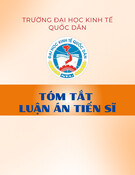
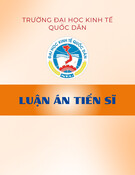
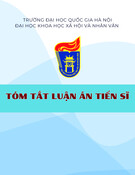
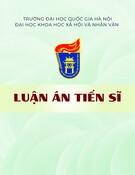
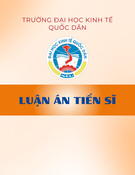
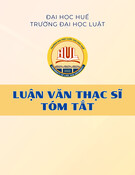




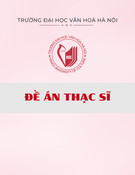


![Đề án Thạc sĩ: Tổ chức hoạt động văn hóa cho sinh viên Trường Cao đẳng Du lịch Hà Nội [Chuẩn nhất]](https://cdn.tailieu.vn/images/document/thumbnail/2025/20251202/kimphuong1001/135x160/91661764646353.jpg)
